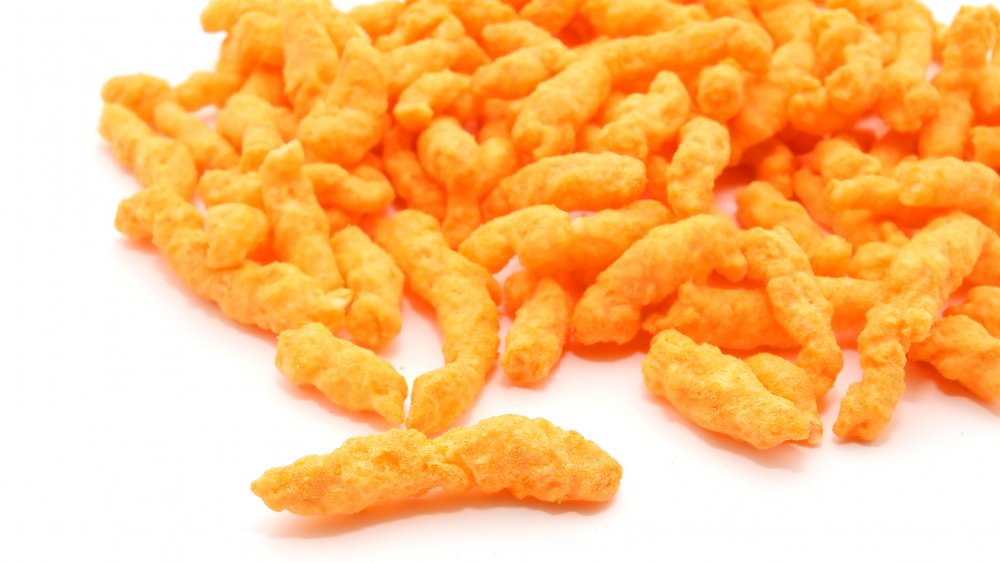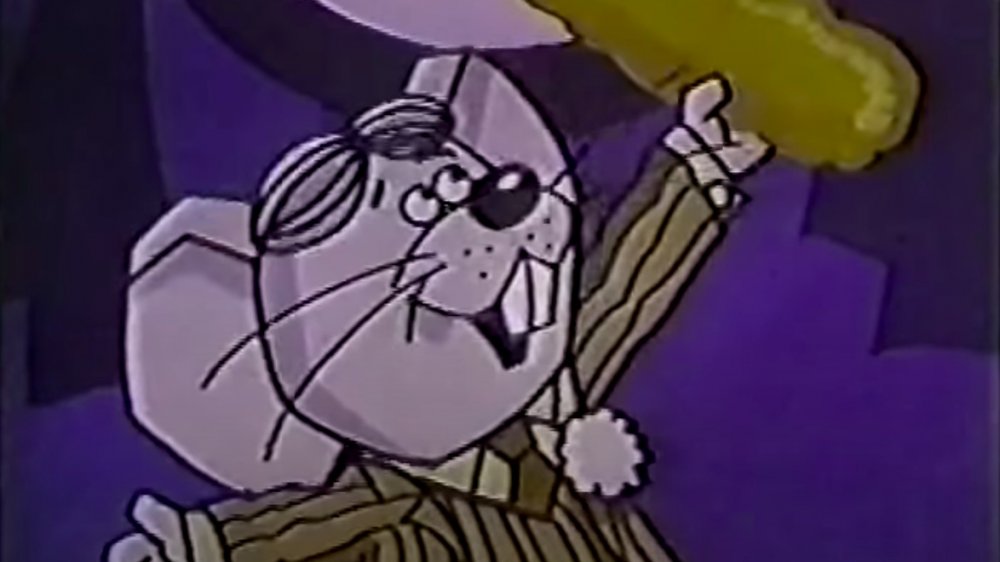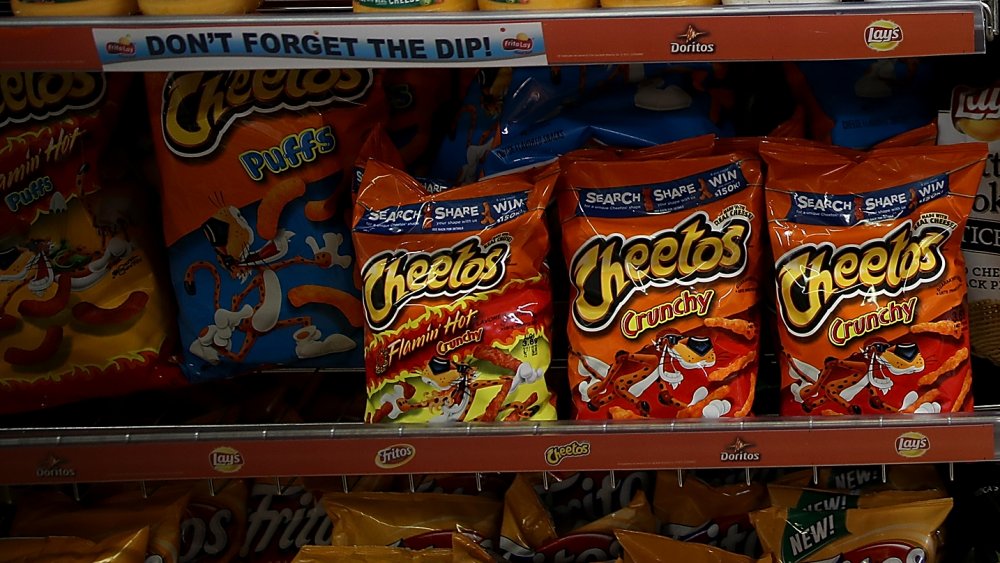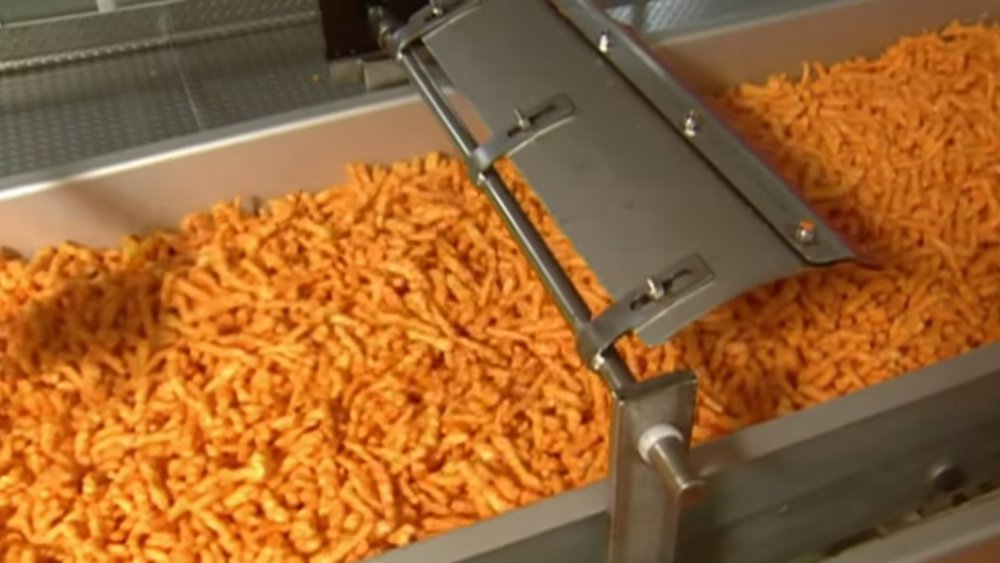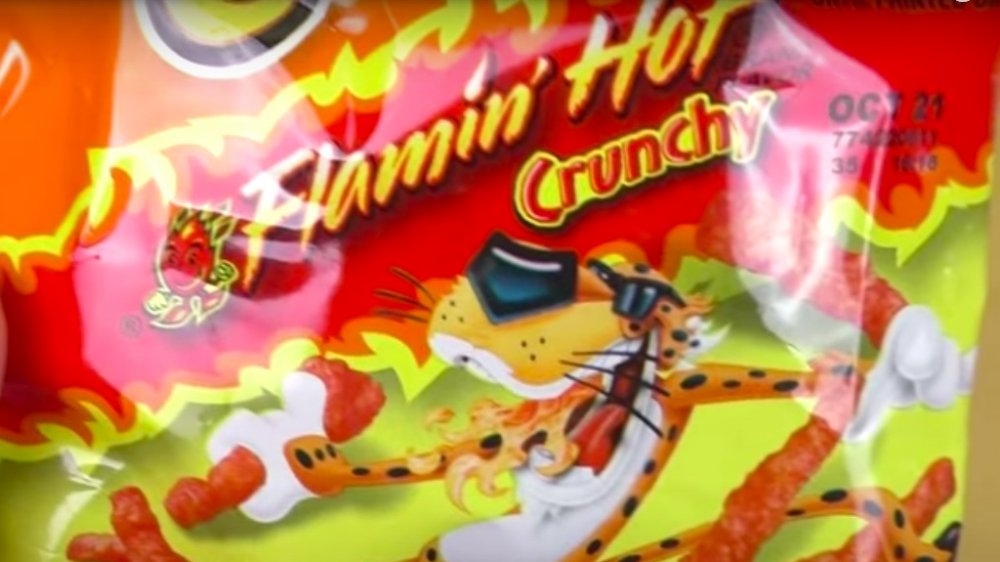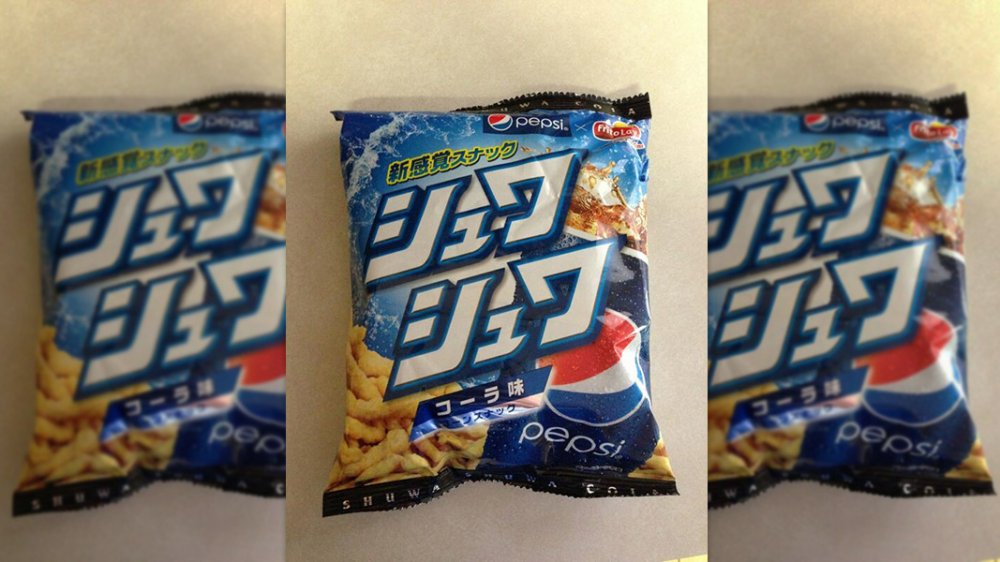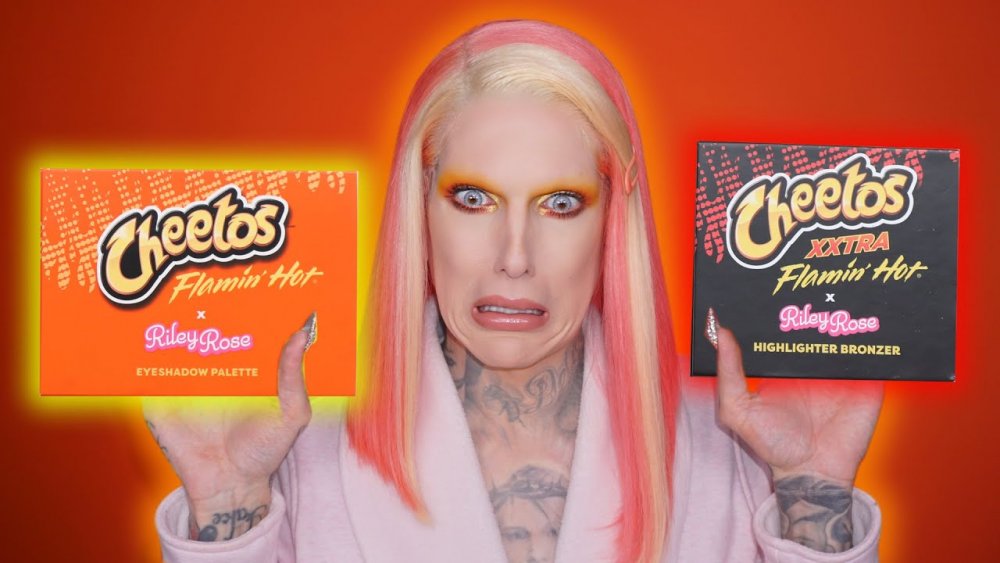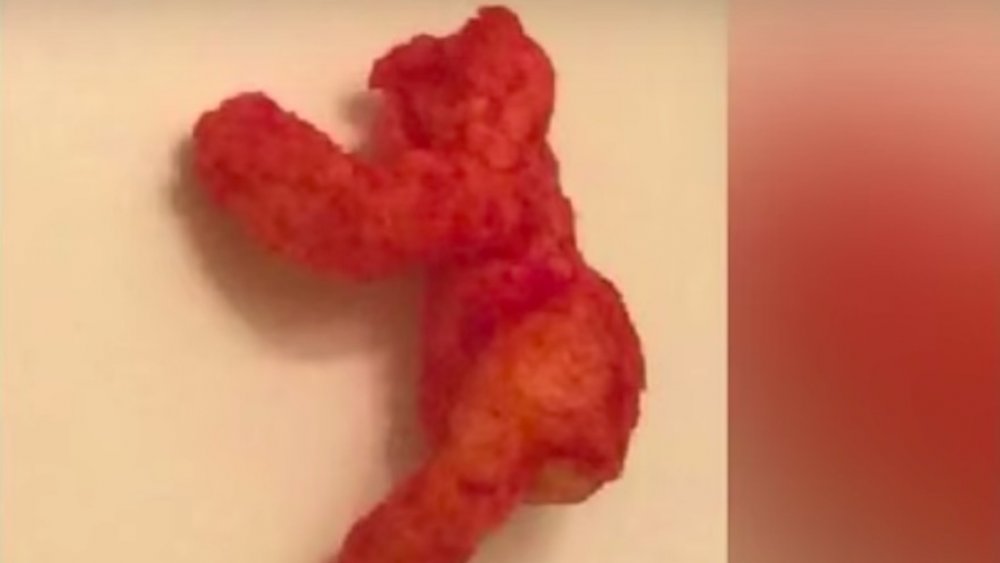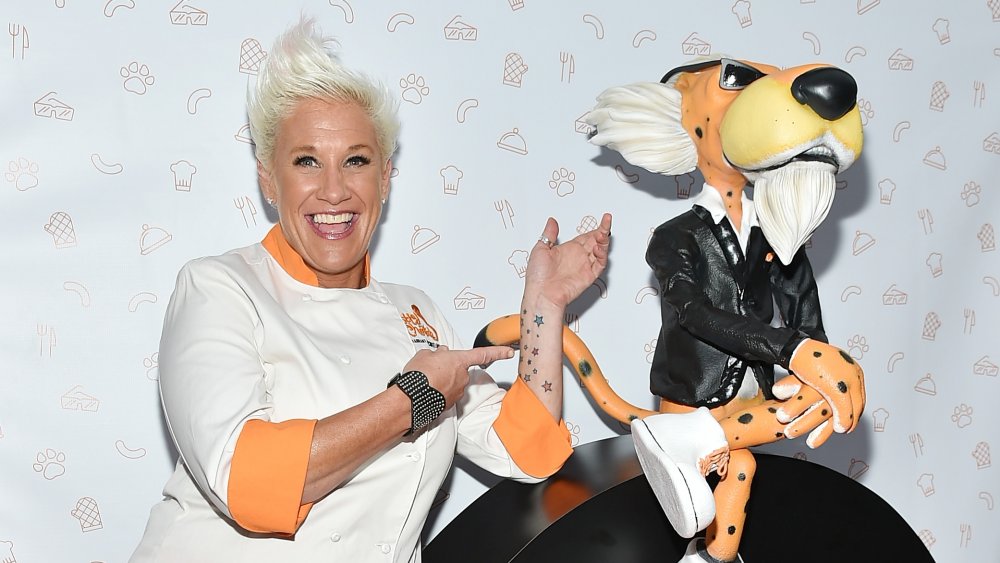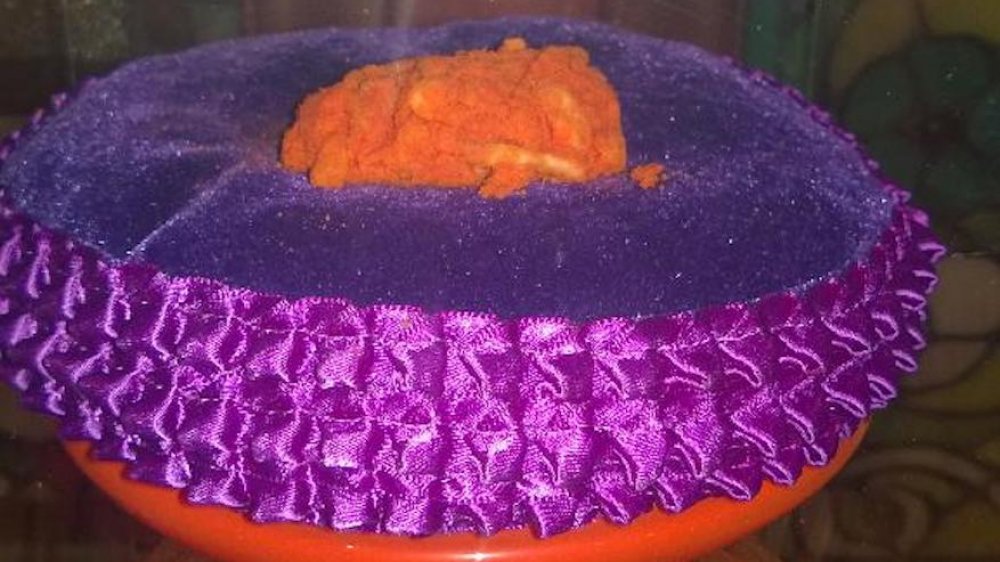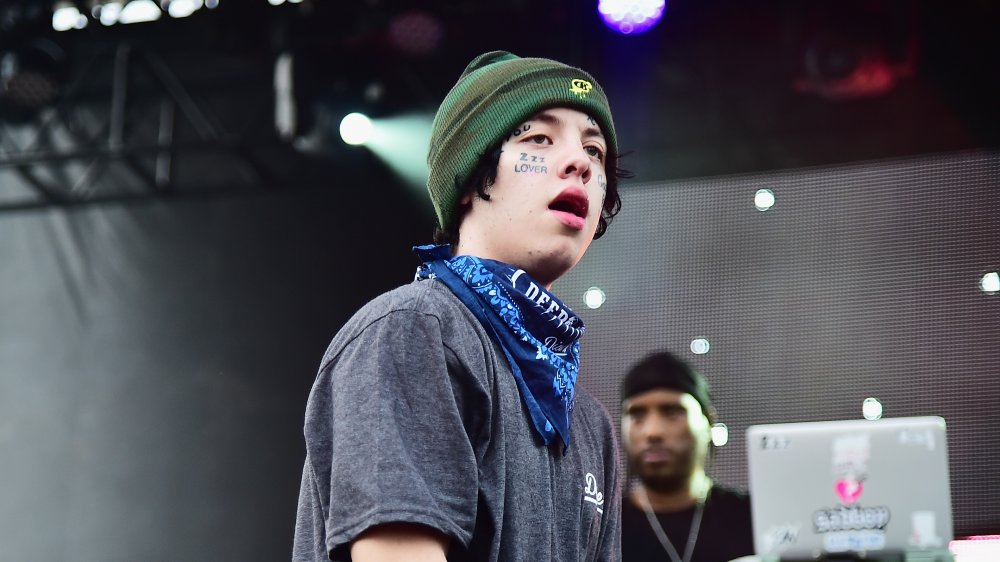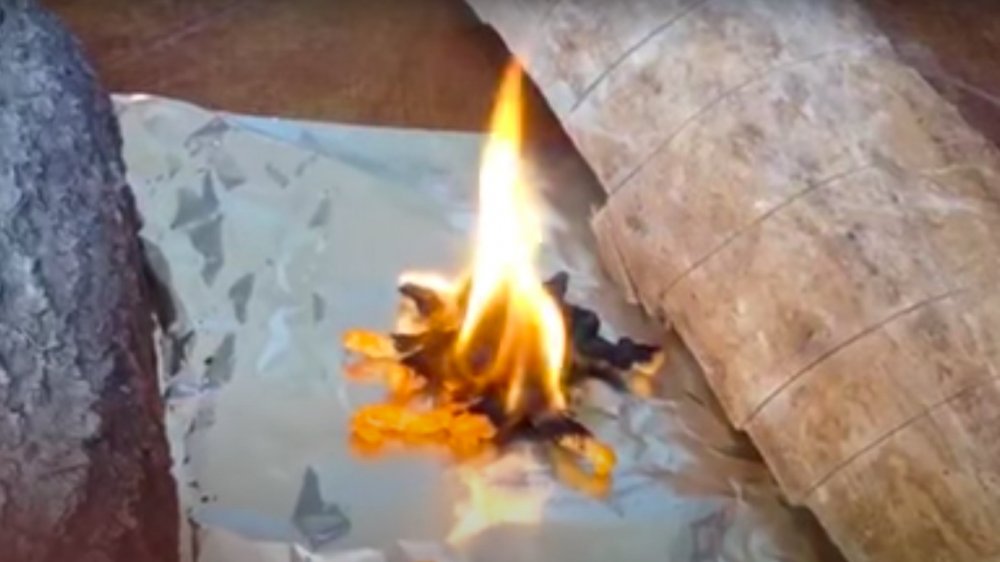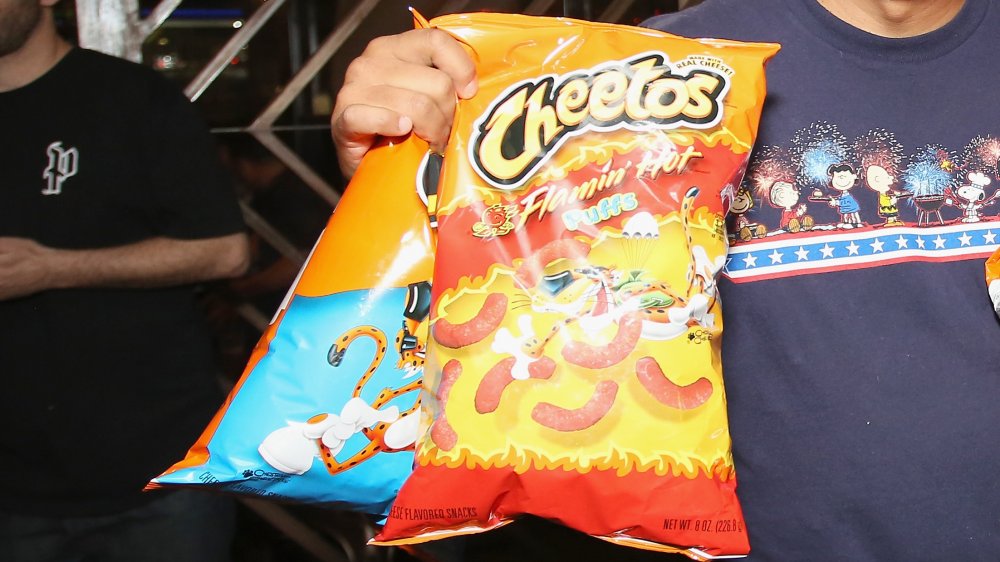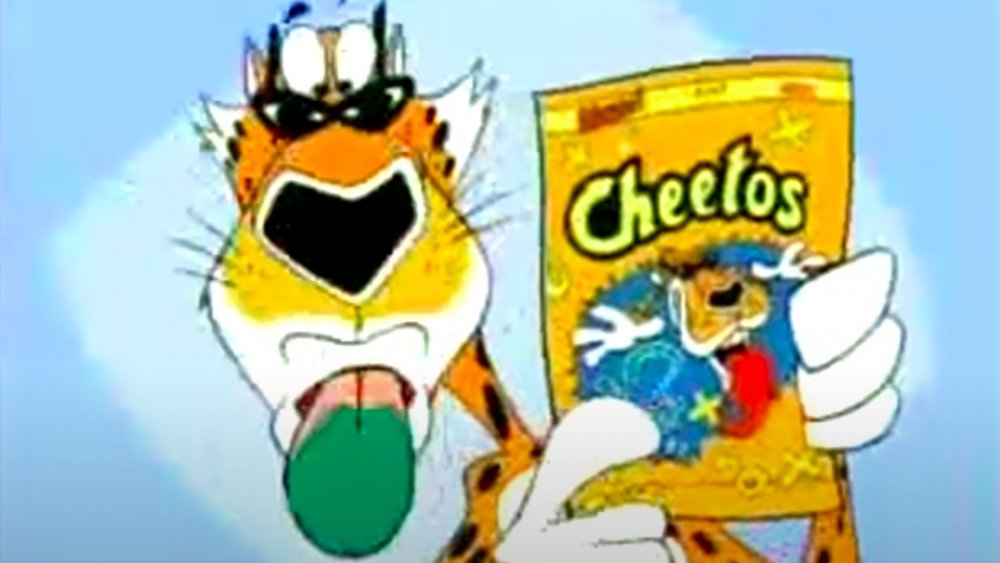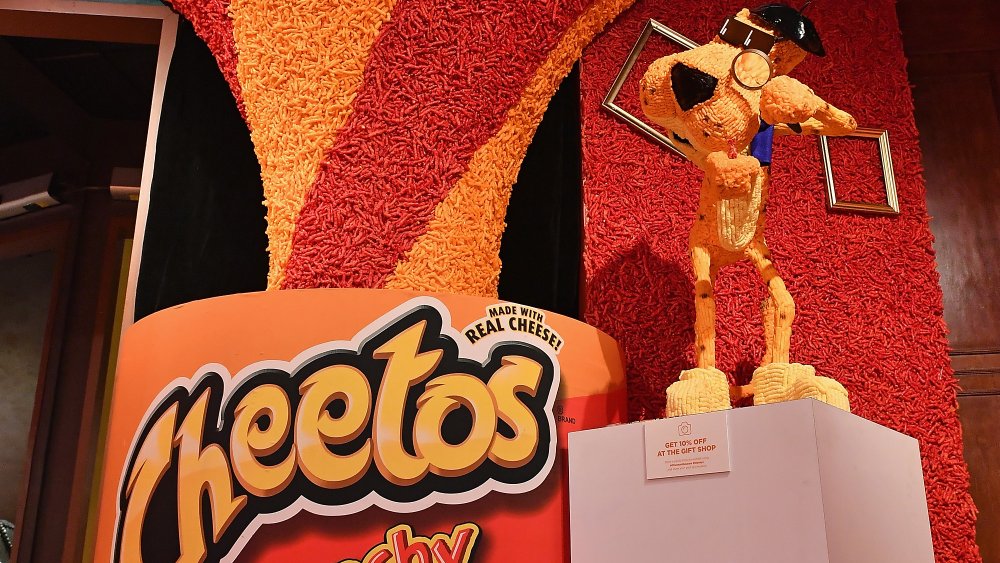The Untold Truth Of Cheetos
From its distinctive neon-orange color to its salty, cheese-imbued flavor, is there any snack more beloved than Cheetos? According to The New York Times, Cheetos were invented by Frito-Lay founder Charles Elmer Doolin after conducting some culinary experiments in his kitchen. As Doolin's daughter told the Times, she and her sisters were used by their dad as "guinea pigs" to taste-test his prototype before Cheetos (which were stylized as Chee-tos until 1998) were ultimately introduced into the marketplace in 1948.
Since then, Cheetos has maintained a ubiquitous presence in the supermarket snack food aisle, available in both crunchy and puffed versions, and in a wide variety of flavor options. In fact, AdWeek reported in 2019 that one variety, in particular, Flamin' Hot Cheetos, had been deemed America's most popular snack food for a third consecutive year.
While there's no denying the popularity of Cheetos, there's actually a lot that the people who consume them may not realize about these cheesy, salty delights. Prepare to find out even more by reading further to delve into the untold truth of Cheetos.
Chester Cheetah was not the first Cheetos mascot
Since the 1980s, Cheetos' television commercials have featured Chester Cheetah, the mischievous mascot with a slick attitude and a constant hunger for cheese-coated corn snacks. "It ain't easy bein' cheesy," the animated feline declared in his earlier iterations, with subsequent catchphrases including "Dangerously cheesy!" and "Take a Cheetos break with Cheetos."
However, Chester was not Cheetos' original mascot. That honor goes to the Chee-tos Mouse (representing the original product name before Chee-tos lost the hyphen to become Cheetos). The Chee-tos Mouse truly loved the snack, trumpeting the catchphrase "Cheese that goes crunch." In addition to its species, the mouse had some significant differences from his successor; he was erudite, snooty and would often be pictured wearing a three-piece suit. One spot depicted the mouse as a politician, while in another he was "Cheesy Rider" in a spoof of the 1969 counterculture classic Easy Rider.
According to Advertising Week 360, the character was designed by artist Paul Coker Jr., a familiar name to fans of Mad magazine from that era, where his illustrations appeared regularly. While the Chee-tos Mouse has faded from memory, promotional items bearing his likeness can still be found on eBay.
Cheetos are scientifically proven to be addictive
If it seems as if eating one Cheeto inevitably leads to eating an entire bag, that's not imaginary — it's science. A jaw-dropping 2013 investigation in The New York Times Magazine took a deep dive into the scientific processes and complicated chemical combinations that go into consumers' favorite snack food.
According to the article, Frito-Lay — manufacturer of Cheetos — has a research facility in Texas "where nearly 500 chemists, psychologists, and technicians conducted research that cost up to $30 million a year." Among the many goals was to attain the perfect degree of crunchiness, aroma, and "mouth feel" — with the latter ensured via a $40,000 piece of equipment that "simulated a chewing mouth." Saying the team took the development of Cheetos seriously would be an understatement.
Food scientist Steven Witherly, author of Why Humans Like Junk Food, told the magazine that Cheetos "is one of the most marvelously constructed foods on the planet, in terms of pure pleasure." He singled out a key factor behind the addictiveness of Cheetos: the way the snack melts in one's mouth. "It's called vanishing caloric density," he explained. "If something melts down quickly, your brain thinks that there's no calories in it... you can just keep eating it forever."
The U.S. military helped invent Cheetos
In the early part of the 20th century, similar experiments in Switzerland and America focused on creating a shelf-stable cheese that could withstand heat and time without turning into a fetid ooze. According to an excerpt from the book Combat-Ready Kitchen: How the U.S. Military Shapes the Way You Eat appearing in Wired, Kraft Foods founder James Kraft was among those experimenting with adding emulsifying salts to cheese, resulting in "a cheese-like product" that could be produced cheaply and lasted far longer than actual cheese.
During World War I, the U.S. Army placed its first order for processed cheese, purchasing 25 million tins from Kraft. Those orders kept coming; in 1944 alone, the Army purchased more than 100 million pounds of the stuff. As a result, the military funded further research into making cheese and other foodstuffs even more long-lasting via dehydration, leading to the development of a cheese powder.
According to the book, in 1948 the Frito Company created its first cheesy snack food using the resultant dehydrated cheese powder. Eventually, the company cooked up a new product made from cornmeal and water that was extruded, puffed with hot air, and then fried in oil before being coated with dehydrated powdered cheese and just like that — Cheetos were born.
Flamin' Hot Cheetos were invented by a Frito Lay janitor
There have been numerous flavor varieties of Cheetos over the years, but one that has demonstrated continued popularity has been Flamin' Hot Cheetos. However, the product may never have come into existence had it not been for former Frito-Lay janitor Richard Montañez. In a video interview for The Washington Post, he joked that his innovation came from having a PhD — that is, "poor, hungry and determined."
According to a CNBC feature on Montañez, he was working at a Frito-Lay factory when one of the machines on the Cheetos assembly line broke down, leaving the snacks without their traditional dusting of cheese powder. This gave him an idea. "What would happen if I put chili on a Cheeto?" he told the Post. To find out, he brought some of those undusted Cheetos home and experimented by sprinkling them with chili powder.
The audacious janitor liked what he tasted. He pitched the product to Frito-Lay's CEO, who loved the concept. This result was a billion-dollar brand and the end of Montañez's job as a janitor; he landed a big promotion and became a PepsiCo executive whose life, reported Variety, is being dramatized in a motion picture.
Cheetos are sold in some weird flavors internationally
Cheetos are available in multiple flavors, ranging from the aforementioned Flamin' Hot variety to others such as White Cheddar. A trip beyond the U.S. borders, however, will bring encounters with many more — and even more unusual — flavors aimed at different international markets. Japanese consumers, for example, can enjoy Pepsi-flavored Cheetos, which The Impulsive Buy blog described as boasting "a pretty accurate flavor recreation" while also representing "the latest food hybrid to spit in the eye of Mother Nature." Also available in Japan: sweet strawberry Cheetos, Mountain Dew Cheetos, Cheeseburger Cheetos, Avocado Salad Cheetos, and Mentaiko Mayo Cheetos, the latter combining the flavors of cod roe and mayonnaise.
Meanwhile, consumers in the European Union can enjoy ketchup-flavored Cheetos, while an Asian variety boasts the distinctive taste of seaweed. As if that's not strange enough, a French traveler to Barcelona recalled coming across Hello Kitty-branded Cheetos. In South Korea, snackers can enjoy Cheetos that purportedly taste like a "European burger," whatever that is, while Vietnam is home to a strawberry-yogurt variety.
Cheetos launched makeup and clothing lines
Coming up with new flavor varieties to tempt tastebuds isn't the only thing the masterminds behind Cheetos get up to. In 2019, reported Business Insider, the snack brand partnered with clothing retailer Forever 21 for a line of Cheetos-themed clothing that included socks, t-shirts and even a dress. "We are so excited to join forces with an iconic snack like Flamin' Hot Cheetos," Forever 21's vice president of merchandising, Linda Chang, said in a statement. "Flamin' Hot Cheetos fans are so fanatical, and over the past couple of years, we have seen their love for this food illustrated all over pop culture, and in particular, via social media. We are so honored to be releasing this limited edition capsule!"
That collaboration between Cheetos and Forever 21 also included a line of makeup, including a Flamin' Hot Highlighter Bronzer. YouTube makeup guru Jeffree Star reviewed the bronzer, and was not impressed. "OK you guys, literally you know I'm not going to cover my whole face with that," he snarked.
That wasn't the first time that Cheetos ventured into similar areas. In 2014, reported HuffPost, Cheetos unveiled Cheeteau, a Cheetos-scented perfume the news outlet described as "a thick, pungent mix of chemical cheese smell and butt."
A Cheeto shaped like Harambe the gorilla sold for nearly $100K
In 2017, Chris Astoyani dug into a bag of Flamin' Hot Cheetos and pulled one out. He was stunned at what he saw, showing the Cheeto to a coworker. As The Los Angeles Times reported, his colleague confirmed that the Cheeto "looks like Harambe," the gorilla who was shot and killed after a young child fell into the animal's enclosure at the Cincinnati Zoo.
Astoyani decided the gorilla-shaped snack could be worth a few bucks, and listed it on eBay with an asking price of $15. When he got no takers, he dropped his price to $11.99. Within days, reported the Times, there had been 132 bids on the Cheeto, with a top bid of $99,900. However, Astoyani told the newspaper that the buyer backed out.
Late-night talk show host Jimmy Kimmel purported to have tracked down the buyer of the Cheeto, and paid the supposed buyer a visit in a filmed bit for his show. In the comedy sketch, Kimmel asked the Cheeto's owner, a lawyer, if he could take a look. When the man pointed to the Cheeto sitting on a shelf, Kimmel proceeded to punch him in the face before popping the Cheeto into his mouth.
A pop-up restaurant served an all-Cheetos menu
While Cheetos are obviously a popular snack food in their own right, what would an entire menu based on Cheetos look like? Diners found that out in 2017, reported People, when the Spotted Cheetah opened its doors. A pop-up restaurant that only existed for three days, the Spotted Cheetah featured Cheetos-inspired culinary creations from celebrity chef Anne Burrell.
"I wanted to marry together the iconic, classic Cheetos and also my own cooking style," Burrell told People. "I really wanted it to be serious food and not a joke where people are like, 'Eh, it was OK for Cheetos food.' I wanted people to say, 'Wow! That was really good and it had Cheetos in it!'"
Among the dishes rated and reviewed by People food writer Mark Marino were Purrfectly Fried Green Tomatoes, which were topped with white cheddar-flavored Cheetos, and Flamin' Hot Cheddar Mac n' Cheetos, which boasted a crust made from Cheetos Flamin' Hot Chipotle Ranch.
The world's largest Cheeto is on display in Iowa
Back in 2003, Navy Petty Officer Mike Evans reached into a bag of Cheetos and pulled out a huge, orange chunk, described by CNN as being "about the size of a small lemon." As Evans told CNN, he attempted to sell the Cheeto on eBay, but eBay canceled the sale when pranksters pushed the bidding to millions of dollars. "I was absolutely astounded that something like a Cheeto could become a pop icon," Evans admitted.
Cheetos development manager Kevin Cogan offered a possible explanation for the giant Cheeto, theorizing that it was actually a big glob of cheese seasoning that had built up in a machine that dispenses the powder onto the snacks. "We call it seasoning accumulation," Cogan said. "If you love cheese, this is the Cheeto for you. It's beyond dangerously cheesy."
Evans ultimately sold his prized Cheeto to a radio station in Algona, Iowa. According to the Wandering the World's Largest blog, as recently as 2016 the Cheeto could still be seen at an Algona restaurant called Emerald's, where it was proudly displayed on top of a purple velvet pillow.
Flamin' Hot Cheetos sent a famous rapper to the ER
As anyone who's ever polished off a bag of Flamin' Hot Cheetos can attest, those suckers are spicy. For proof, ask rapper Lil Xan, who was actually hospitalized due to consumption of Flamin' Hot Cheetos. In a video he shared in a since-deleted Instagram post, reported CNN, he declared that he "ate too many hot Cheetos, and it ripped something in my stomach open and I puked a little blood."
In fact, Lil Xan is far from the only person to visit a hospital after eating the spicy snack. In 2012, CBS News reported on parents who brought their children to the ER after seeing what appeared to be bloody stool, not realizing it was actually just the bright red dye used to color the Cheetos.
After Lil Xan's unfortunate trip to the hospital, Cheetos manufacturer Frito-Lay defended its product. "Flamin' Hot Cheetos meet all applicable food safety regulations, as well as our rigorous quality standards," the company said in a statement to CNN. "That said, we realize some consumers may be more sensitive to spicy foods than others and may choose to moderate consumption or avoid spicier snacks due to personal preference."
Cheetos could save your poorly planned camping trip
Cheetos are known for their cheesy goodness and crispy crunch, but there's another little-known fact about the iconic snack: In a pinch, Cheetos can be used to get a campfire going if there's no dry kindling available. As a video shared on YouTube demonstrates, a Cheeto will easily catch fire when lit by a flame. A different video goes even further to feature how an entire bag of Cheetos can be used to start a campfire.
The oil within Cheetos — and, for that matter, other snacks such as Doritos and potato chips — is what makes them burst into flames. According to a fact sheet about kitchen fires released by Utah's Office of the State Fire Marshal, Cheetos and other types of oily snacks are "all quite flammable," and can be potential fire hazards. "Chips like these are fatty foods and hydrocarbons, both of which burn readily," noted the fact sheet.
It takes a LOT of ingredients to make Cheetos
There is a lot of scientific know-how and complicated chemistry involved in creating the seemingly humble Cheeto. Thrillist broke down the list of ingredients, with the main one being "enriched cornmeal" — that is, cornmeal to which a variety of other things have been added, including riboflavin and folic acid. As Wired explained, the process of transforming kernels of corn into cornmeal essentially strips out all the nutrients, which then have to be added back in artificially.
The cornmeal is then pushed through an extruder, with the resulting uniform-shaped pieces then quickly fried in vegetable oil before being coated in cheese-flavored seasoning. It's that powder, Thrillist pointed out, that contains the bulk of the ingredients listed on the products' packaging. In addition to cheddar cheese and whey, the powder also contains canola oil, maltodextrin, salt, whey protein concentrate, monosodium glutamate, lactic acid, citric acid, and artificial color.
It's that artificial color, Yellow 6 (also known as Sunset Yellow FCF), noted Thrillist, which is the food's most controversial ingredient. The Centre for Science in the Public Interest reported that in animal testing involving the petroleum-based food dye, Yellow 6 was shown to cause "tumors of the adrenal gland and kidney."
Cheetos once tried to turn tongues blue and green
Cheetos are distinctive for their bright orange coloring that easily turns tongues and fingers the same color. Back in 2001, however, Frito-Lay experimented with a new product designed to transform tongues an entirely different color — on purpose. Cheetos Mystery Colorz, reported The Chicago Tribune, had been specially designed to turn the tongue of whoever ate them blue or green, despite the Cheetos themselves boasting the standard orange hue.
According to the Tribune, the Mystery Colorz Cheetos didn't taste any different from standard Cheetos. However, the gimmicky snacks — shaped like Xs and Os — did indeed transform the color of the writer's tongue, with one type turning it green and the other blue. As for how that particular bit of trickery worked, the Mystery Colorz Cheetos were coated in a "color-changing additive" that was activated by saliva, which prompted the color change.
While this variety of Cheetos was only available for a limited time, Dallas Business Journal reported that the product launch was supported by a four-week advertising campaign, spearheaded by TV commercials featuring Cheetos mascot Chester the Cheetah.
There was actually a Cheetos Museum
For a brief, shining time in 2017, serious aficionados of Cheetos could pay homage to the salty snack at the Cheetos Museum. As Food & Wine reported at the time, the Cheetos Museum was a temporary exhibit set up throughout the summer at Ripley's Believe It or Not! in New York City's Times Square.
According to Food & Wine, the Cheetos Museum was as "cheesy" as one would expect, including such exhibits as sculptures made from Cheetos. There was even a contest encouraging fans of the snack to send in photos of the most uniquely shaped Cheeto they could find, with the winner taking home a $50,000 cash prize and earning the honor of having that Cheeto on permanent display as part of Ripley's Believe It or Not! Odditorium collection. The winning entry was a Cheeto shaped like a unicorn, with Frito-Lay senior director of marketing Ryan Matiyow admitting that choosing between the unicorn and the runner up, Flamin' Hot Seahorse, "was a difficult decision."
The most impressive feature of the Cheetos Museum, however, wasn't what was inside the museum, but the walls surrounding the exhibit, which were covered with a whopping 128,900 Cheetos.
